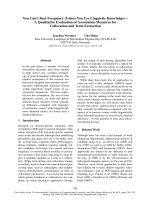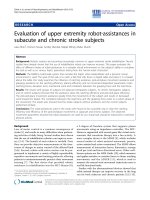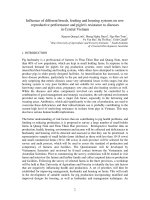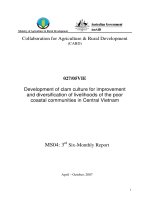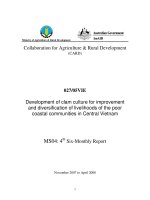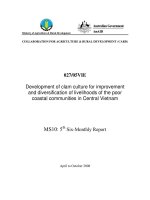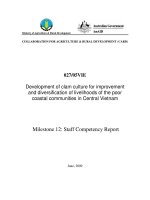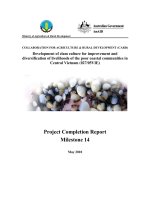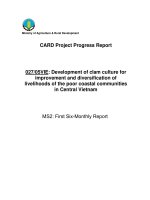EVALUATION OF BIOMASS AND NUTRITI VE VALUE S OF LEPTOCARPUS DISJUNCTUS FOR CATTLE IN CENTRAL VIETNAM - Full 10 điểm
Bạn đang xem bản rút gọn của tài liệu. Xem và tải ngay bản đầy đủ của tài liệu tại đây (464.44 KB, 10 trang )
Evaluation Of Biomass And Nutritive Values Of Leptocarpus Disjunctus For Cattle In Central Vietnam Section A -Research paper
EVALUATION OF BIOMASS AND NUTRITIVE VALUES OF
LEPTOCARPUS DISJUNCTUS FOR CATTLE IN CENTRAL
VIETNAM
Bui Van Loi1*, Doan Trương Phuong Thu2, Pham Thanh3, Nguyen Quang
Linh4
Abstract
Leptocarpus disjunctus Mast. is grown in the provinces of Central Vietnam. The results of the evaluation of
the growth, yield, and nutritional value of this plant grown on the sandy coastal area of Central Vietnam
showed a survival rate was 85 - 90%; at 150 days of age, the tallest plant was 106.62 ± 0.82cm, the grass bed
height was 80.99 ± 0.09 cm. The growth rate peaked in the period of 120 days after planting, then gradually
decreased; The green matter yield, dry matter yield, and protein yield were: 11.7 – 14.2 tons/ha, 4.9 – 5.7
tons/ha, 0.8 – 0.9 tons/ha, respectively; Regarding nutritional composition, DM was 41.73%, CP was 5.88%
in DM, EE was 1.80%, NDF was 70.10%, and Ash was 2.37%, respectively. The cattle ingested L.
disjunctus: 13.93 ± 0.35kg of fresh/day/head, equivalent to 5.61 ± 0.14kg of dry feed/day/head, accounting
for 2.19 ± 0.05% of body weight. L. disjunctus well-using feedstuff ruminants to increase the dietary fiber.
Keywords: Growth, nutrition, dry, cattle, yield.
1*Department of Animal Sciences, Hue University, Vietnam, E-mail:- ,
, Orcid: 0000-0002-4493-2703
2Faculty of Biology, University of Education, Hue University, Vietnam, E-mail:-
, ORCID: 0000-8118-7166
3Department of Animal Sciences, Faculty of Animal Sciences & Veterinary Medicine University of
Agriculture & Forestry, Hue University, Vietnam, E-mail:-
4Department of Animal Sciences, Faculty of Animal Sciences & Veterinary Medicine University of
Agriculture & Forestry, Hue University , Vietnam, E-mail:- ,
, ORCID: 0000-0002-8424-1148
*Corresponding Author: - Bui Van Loi
**Department of Animal Sciences, Hue University, Vietnam, E-mail:- ,
, Orcid: 0000-0002-4493-2703
DOI: 10.53555/ecb/2022.11.11.93
Eur. Chem. Bull. 2022, 11(Issue 11), 1090 – 1099 1090
Evaluation Of Biomass And Nutritive Values Of Leptocarpus Disjunctus For Cattle In Central Vietnam Section A -Research paper
1. INTRODUCTION 2. MATERIALS AND METHODS
Leptocarpus disjunctus, synonymous with 2.1. Research site
Dapsilanthus disjunctus, belongs to the family The experiment was conducted from April 2021
(Restionaceae) [1]. In the regions between to August 2022, in the sandy coastal land of
Australia and Asia, Leptocarpus has three species Quang Thai commune, Quang Dien district, Thua
in Northern Australia, of which two species also Thien Hue Province. The land areas were
present in New Guinea and Aru Islands, also allocated to households with the goal of attaining
extending to Malaysia, Cambodia, and Thailand, self-sufficiency in local consumption. The dry
to the Southeastern Chinese island of Hainan and land area and by site of Tam Giang lagoon, most
their species of the family Restionaceae are of land areas was still planted species as sweet
typically found in heathlands, shrublands, and potato, chili and grass, L. Disjunctus also was
forested areas on nutrient-poor soils and dry developing as wild plant and cover the arid dry
regions, especially in coastal and inland sandy land. Rain fall average in dry season, from April
areas [1]. In practice, the plant are presented more to August, is 1500 mm, The climatic conditions of
in coastal regions of North Central Vietnam Quang Thai are tropical in nature. Precipitation
(Quang Binh, Quang Tri and Thua Thien Hue). even during the driest month. According to Thua
This species to the salt tolerance enables strong Thien Hue’s weather forcast. The average
growth and is consumed as a local vegetable, temperature in Quang Thai in dry period 35.5 °C.
however, local warnings about its side effects This area, situated near the lagoon and coastal
include drowsiness after ingestion [2]. There were line, is characterized by difficult to growth more
conductions by Watchara (2016) was that L. plants.
disjunctus exhibits high levels of vitamin C. They
primarily contain linoleic acid and linolenic acid, 2.2. Materials, animals and experimental
and high levels of potassium and phosphorus [2]. design
In addition to the advantage of protecting and
stabilizing the sandy terrain, L. disjunctus has * Sorting:
greatly contributed to protecting the sustainable - Regnum: Plantae
ecological environment in the central Vietnam - Ordo: Restionales
coastal sandy area [3], and Ham Rong Mountain - Familia: Restionaceae
belonging to Phu Quoc National Park [4]. In - Genus: Leptocarpus
North Central Vietnam, L. disjunctus plant in arid -Species: Leptocarpus
sandy areas for environmental protection, sand disjunctus Mast a
barrier, and as forage for cattle and buffaloes in
dry season. Although, there was no any synonym of
publications and study on this plant, since we Dapsilanthus disjunctus
found the possibilities to dicorvering on nutrive Figure 2.1. Leptocarpus disjunctus
for ruminant and adapted in arid sandy and dry
season. "Evaluating biomass and nutritional value The experiment was randomly arranged with
of L. Disjunctus for cattle in Central Vietnam”, trials (ecah trial with 5 lots for replecated 2 times
aiming to increase the potential plant for in dry season), each slot cover 30 m2/plot (5 x 6
ruminants in dry seasons, poor soil and nutritive m). Then L. disjunctus seedlings were planted on
values. Development of the beef cattle industry in these 5 lots. The time of planting, collecting and
Vietnam has been constrained by limitations in the regime of care and fertilization in these 5 lots
forage supply and quality. In recent years are the same.
numerous high-yielding forage species have been
imported and evaluated for adaptation, biomass Figure 2.2. Soil prepared for planting
yield and quality across Vietnam (Phan Thi Phan
et al. 1999; Truong Tan Khanh 1999), but there is
little evidence of their widespread adoption by
farmers. Improving feeding options by utilizing
locally available feed resources and introducing
new forages remains a key strategy for improving
beef cattle production (Nguyen Xuan Ba et al.
2010).
Eur. Chem. Bull. 2022, 11(Issue 11), 1090 – 1099 1091
Evaluation Of Biomass And Nutritive Values Of Leptocarpus Disjunctus For Cattle In Central Vietnam Section A -Research paper
Figure 2.3. L. disjunctus newly planted - Grass bed height: 5 random points on 2 trials
were selected, the height was measured from the
The soil in the experimental area was taken for ground to on top.
sampling and analysis. Each trail, soil samples
were taken at 5 points, mixed well were taken for - Green matter yield: The amount of L. disjuncts
analysis and soil before planting was cleared of in the experiment slots, including withered
weeds, loosened, and plotted for the experiment at branches, were cut down and weeds removed.
30 cm from each other. When the soil was ready, Cutting was done when it was not raining; all
planting was followed. L. disjuncts were planted the dew had dried, cutting was not too high
in rows, clusters 30 cm apart, planted with (about 5-10 cm from the ground), and eight was
cuttings about 3-5 cm long, taken from the root, scaled right after cutting on the experimental
corresponding to about 3-4 knots on the stem. field to determine the volume of green matter on
Cuttings were transplanted together and planted a plot and yield was calculated, from which can
about 7-10 cm deep in the soil, in rows, 30 cm be converted into tons/ha/batch. Green matter
from each other. 20 days after planting, dead yield was converted into tons/ha/batch using the
bushes were replaced, and weeds were cleared formula:
twice before the crop completely covered the
land. The first batch was harvested after being Green matter yield (tons/ha/batch) = kilograms of
planted for 120 days. The cuts were close to the plants/m2/ ×10,000 m2/1000
root, 3-5 cm from the ground. After each harvest,
fertilization, and top-dressing were done. - Dry matter yield: Dry matter yield = Green
matter yield × % DM. The DM ratio was
2.3. Measures and methods determined by drying samples at a temperature
Time and sites of taking samples: the indicators of 1050C until a constant mass to determine the
were monitored after planting for 10 days, 20 percentage of dry matter.
days, 30 days, 40 days, 50 days, 60 days, 90 days,
120 days, and 150 days. On each lot, 5 points - Protein yield: Protein yield = the dry matter
were selected and sampled, according to the yield × % of Protein present in DM.
diagonal method for tracking indicators.
2.3.2. Nutritional values
2.3.1. Growth and yield of L. disjunctus The samples of the L. disjunctus plant collected
- Number of living plants/shrubs: the number of were sent to the laboratory to be dried, then finely
ground with the size of 1 mm, and then analysed
living plants/shrubs was counted 20 days after for chemical composition, including DM, CP, EE,
planting and before harvest. Survival ratio: ADF, NDF, and Ash. Grass samples were
Calculated by the formula: analyzed for dry matter (DM), total nitrogen and
Survival ratio = (Number of living plants or crude protein (CP) (N x 6.25), total minerals
shrubs/ Total number of plants or shrubs) x (Ash) according to AOAC (1990) [5]; neutral
100% detergent insoluble fiber (NDF) according to Van
- Height of the highest plant: The height Soest et al. (1991) [6], at the Laboratory,
measured from the plant’s root (close to the Analytical Center, Faculty of Animal Husbandry
ground) up to the growth point. How to identify and Veterinary Medicine, University of
and measure plants: The height of the 5 tallest Agriculture and Forestry, Hue University.
plants selected at the monitoring time was
measured in each lot. The distance measured 2.3.3. Feed intake
from the ground to the highest point by leaf -Experiment location: The experiment was
stroking method. conducted at the Center for Animal Husbandry
and Veterinary Medicine Vocational Training and
Practice, under the Faculty of Animal Husbandry
and Veterinary Medicine, University of
Agriculture and Forestry, Hue University, Thua
Thien Hue Province.
- Preparation of feed ingredients: L. disjunctus
was collected before flowering. All grass after
harvesting was brought to the Center for Animal
Husbandry and Veterinary Medicine Vocational
Training and Practice for feeding cows.
- Experimenting: The experiment was conducted
on 4 bulls, Brahman hybrids with an average
Eur. Chem. Bull. 2022, 11(Issue 11), 1090 – 1099 1092
Evaluation Of Biomass And Nutritive Values Of Leptocarpus Disjunctus For Cattle In Central Vietnam Section A -Research paper
weight of 253.25 ± 3.20 kg, which was allowed 2.3.4. Data and calculation
were adapted to their feeding diet for 21 days, The collected data was managed by Microsoft
then samples were collected for 7 consecutive Excel software (2010) and processed by Minitab
days when the cows were fed only experimental software version 19.0 using the ANOVA analysis
grass and ate freely. At the end of the method.
experimental period, the cows were weighed to
calculate the weight gain of the cows. The grass 3. RESULTS AND DISCUSSION
was weighed before feeding, and cows were fed 6 3.1. Soil characteristics
times daily (7:00, 10:00, 13:00, 16:00, 19:00, The results of soil nutrient characteristics analysis
22:0, and 0). Excess feed was weighed the next at the experiment sites are shown in Table 1.
morning. Intake was calculated in kilograms of
DM per day and % of body mass.
Table 1. Soil nutritive variables(n=5)
Variables Unit M ± m
Total nitrogen mg/kg 420.4 ± 21.5
Easily digestible nitrogen mg/kg 13.7 ± 1.25
Total P2O5 mg/kg 14.3 ± 1.84
Easily digestible P2O5 mg/kg 11.2 ± 0.89
Total K2O5 mg/kg 66.7 ± 5.28
Easily digestible K2O5 mg/kg 10.0 ± 0.75
Organic carbon mg/kg 3.2 ± 0.22
Calcium Exchanger (Ca2+) mgdlCa2+/100g 0.81 ± 0.10
It is clearly shown in Table 1 that the soil in the 10.0mg/kg. Compared to the research results of
experiment was poor and sandy. Nitrogen, Van Huu Tap (2016), potassium content was
Phosphate, Potassium, and Calcium indicators assessed to be poor [7]. Calcium Exchanger is an
were assessed to be much lower than the average. important indicator for assessing soil fertility but
According to the assessment and analysis of soil often receives little attention. Regarding fallow
environmental indicators by Van Huu Tap (2016), and arable land, Calcium exchanger below
total nitrogen <0.1%: poor [7]; Easily digestible 2m2/100 g of soil is very poor, 4-8 m2 is average,
nitrogen < 4mg/100mg soil: poor; Total P2O5 < and above 8m2/100 g of soil is considered
0.03%: poor; P2O5: 5-10 mg/100g soil: poor; sufficient [7]. From the results in Table 1, the
Easily digestible K2O5 <10 mg/100g soil: poor. calcium exchanger (Ca2+) in the experimental soil
Nitrogen is the most important nutrient to plants; is 0.81 mgdl Ca2+/100g. This is very nutrient-poor
Nitrogen content is strongly correlated with soil. Thus, according to Van Huu Tap (2016),
humus content. Table 1 shows that the soil's total regarding the nutritional rating of the soil, the soil
nitrogen content and easily digestible nitrogen for the L. disjunctus in the experiment is a very
were 420.4 mg/kg and 13.7 mg/kg, respectively. nutrient-poor sandy soil [7].
The nitrogen content in the assessed soil was very The temperature, humidity, rainfall, and number
poor. The nutrient Phosphate is only behind of sunshine hours of the study area in Quang Thai
nitrogen in the nutritional composition of plants. commune, Quang Dien district, Thua Thien Hue
The total P2O5 and easily digestible P2O5 province, are shown in Table 2 and provides the
content in the test soil was 14.3 mg/kg and 11.2 temperature, humidity, rainfall, and hours of
mg/kg, respectively. Compared to the research sunshine at the area between January 2021 and
results of Van Huu Tap (2016), phosphate content December 2021. The values in the table were
was assessed to be very poor [7]. Potassium is a measured and recorded in the corresponding
nutrient essential to plants, second only to months April to August, the rainfall and huminity
nitrogen and phosphate. According to the are less and sunshine and temperature are higher.
analysis, the content of total K2O5 was 66.7 According to the table above, some of the
mg/kg. This figure shows that the soil had an following points are noticeable. The temperature
average total potassium content, equivalent to gradually increased from January to June, August
about 0.0067% of the total soil. However, the and then decreased until December 12 to March.
easily digestible K2O5 content was only
Eur. Chem. Bull. 2022, 11(Issue 11), 1090 – 1099 1093
Evaluation Of Biomass And Nutritive Values Of Leptocarpus Disjunctus For Cattle In Central Vietnam Section A -Research paper
3.2. Weather and climate characteristics of the experiment regions
Table 2. Temperature, humidity, rainfall, and hours of sunshine in the study area
Index Temperature Humidity Sunshine Rainfall
Month (o C) (%) (hours) (mm)
1 19.8 80.7 77.1 115.4
2 20.4 79.3 129.6 26.6
3 23.1 78.6 157.4 30.4
4 27.1 60.0 146.7 97.6
5 29.8 56.4 164.2 88.2
6 32.0 55.0 169.3 65.3
7 33.8 45.9 152.2 64.8
8 34.7 47.0 137.1 56.7
9 28.3 83.7 125.6 219.9
10 26.7 80.9 102.9 393.9
11 23.6 77.6 117.1 244.8
12 21.4 77.1 90.4 80.7
M ± m 25.3 ± 81.1 ± 123.3 ± 179.0 ±
3.3. Growth ability of L. disjunctus grass, the taller the plant is, the greater the green
3.3.1. Survival rate matter biomass is. Grass bed height is related to
One of the important indicators closely related to productivity, covering ability, and picking
the vitality, resistance, adaptation, and convenience. The height difference through the
development of grass to soil conditions, weather, stages of growth is presented in Table 3. L.
climate, later lawn density, and the composition disjuncts is a herbaceous plant, with standing
of grass productivity is the survival rate of the stems, and average plant height compared to
grass. The survival rate was 85 - 90%, and the grassy plants with standing stems. Table 3 shows
plant had vitality, adaptability, and high growth the aver that the average height of L. disjunctus
on coastal sandy lands. According to the research plant at 150 days of age is 106.62 cm, equivalent
results of Ho Van Trong et al. (2021), Ghine grass to ghine grass of about 80.9 – 111.3 cm and grass
and Mulato II grass when grown in Dien Bien at of about 90.2 cm [11]. The Guatemala grass
the time after planting for 30 days, survival rate height is 110.0 cm, the elephant grass height is
was 96.56% and 92.31%, respectively [8]. The 113.4 – 148.0 cm, and the Panicum maximum
Guatemala grass survival rate is 82.2%, the TD58 grass height is 80.2 cm [9]. According to
elephant grass survival rate from 85.7 – 96.1%, the research results of Ho Van Trong et al. (2021),
the Panicum maximum TD58 grass survival rate is the grass height is 82.61 cm, and in trial 2, the
98.2%, and the Mulato II survival rate is 96.5% grass height was 90.87 cm [8]. According to the
[9]. Thus, it can be seen that the vitality, research results of Tu Quang Hien et al. (2017),
adaptability and growth of the L. disjunctus Mast. Stylosanthes guianensis CIAT 184 grass when
were high, which initially reflected the growth grown in Thai Nguyen at the time after planting
potential and close relation to the uniformity of for 30 days, 60 days, 90 days, and 105 days,
the grass and the high ability to adapt to the respectively: 14.4 cm, 51.5 cm, 83.8 cm and 94.9
experimental soil. cm high [10]. To conclude, L. disjunctus in the
study is of moderate height compared to other
3.3.2. Growing herbaceous plants.
Plant height is one of the important indicators of
the growth and development of food plants. For
Table 3. The height of the tallest L. disjunctus plant through growth timelines (cm/day)
Growth Height Height growth Height growth
Time (days) M ± m M ± m M ± m
0 0 ± 0e 0 ± 0f
10 1 ± 0 14.38 ± 0.5b 1.44 ± 0.05a
20 15.38 ± 0.51i 3.98 ± 0.10de 0.39 ± 0.01d
30 19.35 ± 0.56h 4.23 ± 0.19de 0.42 ± 0.02d
40 23.58 ± 0.42g 6.69 ± 0.32d 0.67 ± 0.03c
50 30.27 ± 0.36f 8.52 ± 0.47c 0.85 ± 0.05b
60 38.79 ± 0.27c 9.45 ± 0.57c 0.95 ± 0.06b
90 48.24 ± 1.72d 40.02 ± 0.91a 1.33 ± 0.03a
88.26 ± 1.26c 14.25 ± 0.68b 0.48 ± 0.03d
120 102.50 ± 1.08b
Eur. Chem. Bull. 2022, 11(Issue 11), 1090 – 1099 1094
Evaluation Of Biomass And Nutritive Values Of Leptocarpus Disjunctus For Cattle In Central Vietnam Section A -Research paper
150 106.62 ± 0.82a 4.11 ± 1.1de 0.14 ± 0.04e
F 2894.937 370.442 184.928
P <0.001 <0.001 <0.001
The values in the column represent the mean and error. The column letters represent the difference between
experimental formulas by single-factor variance analysis and the T-Test.
Increases in plant height and height increase rate guianensis CIAT 184 grass, when grown in Thai
over different growth milestones were different Nguyen from 15 days after planting to 30 days,
and statistically significant (P < 0.001). The the plant height increased slowly 0.35 – 0.61
highest increase in plant height and the highest cm/day [10]. From 30 days old to 90 days old, the
rate of increase was in the period after planting to plant grew faster, and this was the time when the
10 days of age (1.44 cm/day). According to the plant grew fastest (0.67 – 0.95 cm/day); S.
research results of Ho Van Trong et al. (2021), guianensis CIAT 184 grass when grown in Thai
shine grass’s highest increase rate is 1.34 cm/day, Nguyen from 30 days after planting to 90 days,
and Mulato II grass’s highest increase at 1.49 the plant height increased 0.61 – 0.97 cm/day
cm/day [10]. This could be due to plant [10]. In the period from 90 to 120 days of age, the
physiological characteristics and forced growth height of the plant increased insignificantly, this
because the plant was grown from seed bushes. was the period when the plant concentrated
The plant grew at a high speed while struggling nutrition to develop stems and complete plant
for survival so that the plant could survive and physiological functions. According to the research
develop further. results of Tu Quang Hien et al. (2017), S.
guianensis CIAT 184 grass when grown from 90
From 10 days after planting to 30 days, the plant days after planting to 105 days, the plant height
height increased slowly (0.39 – 0.42 cm/day), and increased (0.74 – 0.97 cm/day [10]. In the period
there was no statistically significant difference. At of 120 to 150 days old, the plant’s growth rate
the time, the plant's main activity was to form and decreased sharply (0.14 cm/day). This was also
finish forming vegetative organs such as roots, when the plant began to perfect plant
stems, leaves, and branches. According to the physiological functions and flower.
research results of Tu Quang Hien et al. (2017), S.
3.3.3. Grass bed height
Table 4. Grass bed height of L. disjunctus through growth timelines (cm/day), n=5
Growth Height Height Increased Height
Time (days) M ± m M ± m M ± m
0 1 ± 0e 0 ± 0f 0 ± 0f
10 7.76 ± 0.16f 6.76 ± 0.16d 0.67 ± 0.02d
20 8.82 ± 0.14f 1.06 ± 0.29f 0.11 ± 0.03e
30 10.19 ± 0.05ef 1.37 ± 0.09f 0.14 ± 0.01e
40 11.67 ± 0.05ef 1.48 ± 0.00f 0.15 ± 0.00e
50 12.94 ± 0.02e 1.27 ± 0.03f 0.13 ± 0.01e
60 23.25 ± 0.05d 10.30 ± 0.06c 1.03 ± 0.01a
90 47.33 ± 0.60c 24.08 ± 0.64b 0.80 ± 0.02c
120 77.09 ± 1.05b 29.7 ± 0.80a 0.99 ± 0.03a
150 80.99 ± 0.09a 3.89 ± 1.02e 0.13 ± 0.03e
F 5832.927 500.413 467.839
P <0.001 <0.001 <0.001
The values in the column represent means and errors. The column letters represent the difference between
experimental formulas by single-factor variance analysis and the Turkey test.
The grass bed height represents the uniform rate was consistent with increasing the tallest
growth of plants, reflecting yield. The results of plant height. Grass bed height had statistical
assessing the height of the L. disjunctus grass bed significance (p < 0.001) in which grass bed height
are shown in Table 4 and had a rather high grass increased over time, and reached the highest
bed height, of which the average at 150 days old growth index at 150 days at 80.99 cm. However,
was 80.99 cm. According to Tu Quang Hien et al. the grass bed height growth rate had a statistically
(2017) research results, S. guianensis CIAT 184 significant difference during the monitoring
grass when grown in Thai Nguyen height of 68.3 period. The grass bed's height increase and the
cm [10]. Increasing grass bed height and increase growth rate is highest from planting to 10 days of
Eur. Chem. Bull. 2022, 11(Issue 11), 1090 – 1099 1095
Evaluation Of Biomass And Nutritive Values Of Leptocarpus Disjunctus For Cattle In Central Vietnam Section A -Research paper
age. As analyzed above, this was the strongest gradually decreased. Therefore, in cultivation,
growth period for L. disjunctus to ensure its harvest should be at 120 days of age to obtain the
survival and development. In the period from 10 highest fresh biomass.
days to 50 days of age, the growth rate in the
height of the grass was from 0.11 to 0.15 nm/day, 3.4. Production and yield
and there was no statistically significant Green matter yield, dry matter yield, and protein
difference. This shows that the height increase of yield of grass are important foundations for
the grass bed of L. disjunctus is quite uniform and assessing the plant’s potential, thereby developing
suitable for crop growth. The period from 50 to development strategies in animal husbandry. The
60 days of age was when grass bed height average green matter yield, dry matter yield, and
increase rates were highest (1.03 cm/day), and the grass protein yield of postharvest regenerated
difference is statistically significant at all times of grass are shown in Table 5.
growth, except at 120 days of age and then
Table 5. Green matter yield, dry matter yield, protein yield in different lands (tons/ha/batch)
Monitoring indicators FM DM CP
Harvesting M ± m M ± m M ± m
Batch 1 11.7 ± 0.03b 5.00 ± 0.00b 0.80 ± 0.00b
Batch 2 14.2 ± 0.03a 5.70 ± 0.01a 0.90 ± 0.00a
Batch 3 12.8 ± 0.05ab 4.90 ± 0.02b 0.80 ± 0.00b
F 10.422 462.211 8.092
P 0.002 <0.001 0.006
The values in the column represent the mean and error. The column letters represent the difference between
experimental formulas by single-factor variance analysis and the Turkey test.
3.4.1. Biomass (FM) were harsh, green matter yield is lower than
The experiment results showed that the green grasses grown under favorable conditions.
matter yield of L. disjunctus obtained at the study
site had an average value of 11.7 – 14.2 3.4.2. DM
tons/ha/batch. According to the research results of The dry matter yield obtained in this study was
Phan Thi Hong Nhung et al. (2020), the green 4.9 – 5.7 tons/ha/batch (Table 5). The dry matter
matter yield of ruzi grass ranged from 15.3 yield of P. atratum grass ranged from 4.05 – 6.26
tons/ha/batch, and the green matter yield of ghine tons/ha/batch [12]. The dry matter yield of some
grass ranged from 13.6 tons/ha/batch [11]. dairy feed plants grown in Nghe An such as
According to Tu Quang Hien et al. (2017) Croatataria was 0.96 tons/ha/batch, B. bean was
research results, S. guianensis CIAT 184 grass 4.61 tons/ha/batch, S. ten was 0.43 tons/ha/batch,
ranged from 10.6 – 33.7 tons/ha/batch, an average and E. cowpean was 5.47 tons/ha/batch [13].
of 19.4 tons/ha/batch [10]. The green matter yield Compared with Nguyen Thi Hoa Binh's study, the
of Paspalum atratum grass ranged from 16.64 – dry matter yield of L. disjunctus was lower than
26.58 tons/ha/batch [12]. The green matter yield that of other grasses such as Taiwanese nappies
of some dairy feed plants grown in Nghe An such grass (14.97 tons/ha), Elephant grass (9.34
as the Croatataria plant was 4.7 tons/ha/batch, tons/ha), Purple Elephant grass (9.85 tons/ha),
the Burgady bean plant was 9.00 tons/ha/batch, VA06 grass (12.15 tons/ha) [14].
the Sardy ten plant was 1.57 tons/ha/batch and
Ebody cowpean plant was 13 tons/ha/batch [13]; 3.4.3. Protein
The grass ranged 3.09 tons/ha/batch, Mulato II, Similar to the green and dry matter yields, the
grass ranged 3.66 tons/ha/batch [10]. According protein yield of L. disjunctus grown in the study
to the research cultivation of Twanese nappies area was 0.8 – 0.9 tons/ha (Table 5), which was
grass by Nguyen Thi Hoa Binh (2017) at the lower than that of other grass varieties namely
Vietnam Institute of Agriculture, the result is Twanese nappies, Elephant grass, Purple Elephant
79.43 tons/ha, for elephant grass 61.57 tons/ha, grass, VA 06 grass which was 1.08 tons/ha; 0.86
purple elephant grass 61.75 tons/ha, VA06 grass tons/ha, 0.92 tons/ha and 1.37 tons/ha,
is 73.94 tons/ha [14]. This research showed that respectively [14]. The protein yield of Paspalum
the green matter yield of L. disjunctus is low atratum grass ranged from 0.32 – 0.62
compared to the grasses mentioned above. tons/ha/batch [12]. The protein yield of some
Because the composition of the soil was nutrition- dairy feed plants grown in Nghe An such as
poor and ecological conditions in the study area Croatataria was 0.2 tons/ha/batch, B. bean was
Eur. Chem. Bull. 2022, 11(Issue 11), 1090 – 1099 1096
Evaluation Of Biomass And Nutritive Values Of Leptocarpus Disjunctus For Cattle In Central Vietnam Section A -Research paper
1.0 tons/ha/batch, S. ten was 0.1 ton/ha/batch and 3.5. Nutritional values
E. cowpean was 1.2 tons/ha/batch [13]. The results of the analysis of the composition and
nutritional value of the L. disjunctus grown in
Thua Thien Hue are presented in Table 6.
Table 6. Chemical ompostion (%DM), n=5
Variables DM CP EE CF ADF NDF Ash
M ± m 41.73 ± 2.42 5.88 ± 1.80± 43.58 ± 3.41 41.83 70.10 2.37
0.57 0.25 ± 3.21 ± 5.34 ± 0.18
DM (%): dry matter, CP (%DM): crude protein, EE (%DM): ether extract, CF (%DM): crude fiber, ADF
(%DM): acid detergent fiber, NDF (%DM) neutral detergent insoluble fiber.
Table 6 shows that the study's nutritional value of CIAT 184 grass of 0.45% [10]. The CF content
L. disjunctus was quite high among forage plants. (%DM) of L. disjunctus was relatively high.
According to the results of the analysis, the According to Tran Van Thang et al. (2018), the
chemical composition of L. disjunctus such as dry CF ratio of Elephant grass VA06, Ghine Hamil,
matter (DM), crude protein (CP), ether extract Decumben grass, and Ruzi grass ranged from
(EE), crude fiber (CF), acid detergent insoluble 20.17 – 30.83% [18]. In contrast, the NDF content
fiber (ADF), neutral detergent insoluble fiber (%DM) of L. disjunctus in all three periods was
(NDF) was quite high (Table 6). For the DM quite high, and there was a statistically significant
indicator, the average result was 41.73% (Table difference (P < 0.001). The pre-flowering NDF
6). The feed intake by cattle depends on many was 68.50%, and during the flowering phase was
factors, including the occupancy of the feed in the 70.14%. The ADF content (% DM) of L.
stomach. Analysis of the dry matter content in the disjunctus was 41.83%. The ADF content of L.
grass plays a very important role because dry disjunctus in all 3 stages was higher than the ADF
matter affects the ability of cattle to absorb feed. content of Elephant grass VA06, Hamil,
Food containing a lot of water reduces the feed Decumben grass, and Ruzi grass, ranging from
ingested by cattle and is difficult to store and 27.93 – 33.93% in the study of Tran Van Thang et
process. The DM of L. disjunctus was quite high. al. (2018) [18]. The Ash rate (%DM) of L.
The DM of Elephant grass VA06 was 15.52% disjunctus obtained in the study was 2.37%. This
[15]; Hamil grass was 21.54%; was 21.63%; Ruzi number was lower than the Ash content of other
grass was 25.58% [11]; TD58 grass was 23.70%, grass varieties (Elephant grass VA06, Hamil, and
VA06 grass was 15.70%, Mulato II grass was Ruzi grass were 9.25%, 7,05%; 9,17%; 8.93%,
22.33% [9], Ruzi grass was 23.20% and Paspalum respectively) in the study published by Tran Van
grass was 20.63%, the CP content of L. disjunctus Thang et al. (2019) [15]; Stylosanthes guianensis
was 5.88% (% DM) [16]. Thus, the CP content of CIAT 184 grass of 1.93% [10].
the obtained L. disjunctus plant is lower than that
of some other forages, specifically: according to 3.6. Feed Intake
the analysis results, the CP content of ruzi grass The experiment was conducted on 4 individual
was 12.7%, Elephant VA05 grass was 10.0%, Brahman and showed that cows could digest L.
Elephant grass was 7.2%, the grass was 14.3% ơ; disjunctus well. The L. disjunctus Table 7., intake
Hamil grass was 9.72%, Decumben grass was was 13.29 – 14.43 kg of fresh feed/day/head,
10.96% [18]; western grass was 8.75% (Nguyen equivalent to the amount of ingested dry feed of
Van Thu (2010) [17]; TD58 grass was 7.28%, 5.35 - 5.81 kg/day/head, accounting for 2.12 -
Mulato II was 9.54% [16]. However, compared to 2.33% of body weight. According to McDonald et
rice straw and some other forages, the CP content al. (2002), beef cattle’s DM intake is estimated to
of L. disjunctus improved significantly, and the be 2.2 % of body weight, while dairy cows’ intake
CP content of S. guianensis CIAT 184 grass when is about 2.8 %, higher at the beginning of the
grown in Thai Nguyen was 3.59% [10]. lactation cycle and 3.2 % at peak intake [19].
Therefore, when using the L. disjunctus as feed Thus, this experiment's amount of L. disjunctus
for ruminant cattle, it is necessary to add CP-rich intake is consistent with the above
concentrates to balance livestock nutrition. recommendations (2.12 – 2.33% of body weight).
The estimated amount of feed intake by cows to
The EE content (%DM) of L. disjunctus was assess feed quality. Accordingly, the author
1.80%. This number is higher than Ghine Hamil proposed 5 recommended levels of dry matter
grass at 1.32%, Decumben grass at 1.52%, Ruzi daily intake (% of body mass): 3.0 – very good;
grass at 1.45% [18], Stylosanthes guianensis 2.5 – good. 2.0 – average; 1.5 – bad and 1.0 –
Eur. Chem. Bull. 2022, 11(Issue 11), 1090 – 1099 1097
Evaluation Of Biomass And Nutritive Values Of Leptocarpus Disjunctus For Cattle In Central Vietnam Section A -Research paper
very bad. Thus, according to the above ingested by cows is good (2.12 – 2.33% of body
assessment frame, the amount of L. disjunctus weight).
Table 7. Feed maximum intake and growth performance of L. disjunctus
Indicators n M ± m
Initial weight (kg) 5 253.25 ± 3.20
After feeding (kg) 5 262.25 ± 0.35
Growth g/day 5 321.43 ± 0.12
FM (kg/day/head) 5 13.93 ± 0.35
DM (kg/day/head) 5 5.61 ± 0.14
CP 5 0.86 ± 0.21
% BW 5 2.19 ± 0.05
4. CONCLUSIONS ADMIN/Downloads/CB45.Phan%20bo.8p.36
- The survival rate was 85 - 90%, and the plant 1-368%20(1).pdf
4. Dang Minh Quan, Nguyen Minh Chuong,
had vitality, adaptability, and high growth on Phan Hoang Gieo, Nguyen Nghia Thin.
coastal sandy lands in 150 days. The long size (2012). Investigating vegetal diversity in Ham
was 106.62 ± 0.82cm, and the grass height was Rong Mountain of Phu Quoc National
80.99 ± 0.09cm and then gradually decreased Park. Journal of Science Can Tho University,
afterward, obtaining the highest fresh biomass. 2012, 21a: 92-104.file:///C:/ Users/ADMIN/
Green matter yield, dry matter yield, and protein Downloads/trongtruong_so21a_11%20(1).pdf
yield were 11.7 – 14.2 tons/ha/batch, 4.9 – 5.7 5. AOAC (1990). Official Methods of Analysis.
tons/ha/batch, and 0.8 – 0.9 tons/ha/batch, 15th Association of Official Analytical
respectively. Chemists, Washington, DC., USA.
- Nutritional value composition: DM was 41.73%, /> CP was 5.88% (% DM), EE was 1.80% (% ds.1.1990/page/n33/mode/2up
DM), NDF was 70.10% (%DM) and Ash was 6. Van Soest, P.J., Robertson, J.B., Lewis, B.A.
2.37% (% DM). Cows ingested 13.93 ± 0.35kg (1991). Methods for dietary fibre, neutral
of fresh feed/day/head, equivalent to 5.61 ± 0.14 detergent fibre and non-starch polysaccharide
kg/day/head of dry food and 2.19 ± 0.05% of in relation to animal nutrition. Journal of
body weight. Dairy Science74, 3583-3597.
/>Acknowledgement pii/S0022030291785512\.
7. Van Huu Tap (2016), Assessment and analysis
References of soil environmental indicators.
1. Briggs, B.G. (2001). The reads invade the /> tich-cac-chi-tieu-moi-truong-dat/
north: the diaspora of the Restionaceae. Faunal 8. Ho Van Trong, Doan Duc Lan, Vang A Me
and floral migrations and evolution in SE and Le Xuan Tung (2021). Evaluating the
Asia–Australasia. Balkema, Lisse, The growth and green matter yield of chine grass
Netherlands, 237-241. tledge. and Mulato II grass planed in PU Nhung
com/Faunal-and-Floral-Migration-and- commune, Tuan Giao district, Dien Bien
Evolution-in-SE-Asia-Australasia/Metcalfe- province. Journey Science – Tay Bac
Smith-Morwood- University, (24), 50-55.
Davidson/p/book/9789058093493 />2. Damjuti, W. (2016). Pharmacological ence/article/viewFile/347/401
activities and nutritional compositions of 9. Nguyen Xuan Cu and Dao Ba Yen (2017).
Leptocarpus disjunctus. PhD Thesis. Chula- Selection of High-yielding Tree and Grass
longkorn University. Species for Cattle Feed Suitable for Ecological
Conditions in Ha Giang. Journal Science
1/aaf9325de5a2cc76ab284832e00d91bd? Journal Science VNU: Earth and
3. Hoang Xuan Thao; Truong Thi Hieu Thao, Environmental Sciences, 33 (2017), 1-6.
Nguyen Khoa Lan (2020). Diversity of file:///C:/Users/ADMIN/Downloads/4131-49-
flowering plants in natural vegetation in 8384-1-10-20180209%20(1).pdf
Quang Tri province’s sand dune region. Hue 10.Tu Quang Hien, Tran Thi Hoan and Tu Quang
University Journal of Science: Natural Trung (2017). A study on the green matter and
Science, 2020, 129.1C: 31-42. file:///C:/ Users/
1098
Eur. Chem. Bull. 2022, 11(Issue 11), 1090 – 1099
Evaluation Of Biomass And Nutritive Values Of Leptocarpus Disjunctus For Cattle In Central Vietnam Section A -Research paper
grass meal production performance of 17.Nguyen Van Thu (2010), Influence of dietary
Stylosanthes guianensis CIAT 184 cultivated crude protein levels on feed consumption,
in Thai Nguyen Province. Vietnam Journal nutrient digestibility, rumen parameters,
Science and Technology, 19(8) 8.2017. nitrogen accumulation and weight gain of
cows, Can Tho University Journal of Science,
27.pdf 15a 125-132.
11.Phan Thi Hong Nhung, Duong Thi Thu Hang, /> Tran Thi Minh Ngoc, Nguyen Van Loc, Tang icle/view/789/3030
Thi Hanh, Nguyen Viet Long (2020).
Evaluation of the Growth, Yield and Quality 18.Tran Van Thang, Ta Van Can, Nguyen Van
of Some Forage Species at the Different Dai and Nguyen Hữu Hoa (2018).
Cutting Times in Gia Lam, Hanoi. Vietnam Determination digestibility and metabolizable
Journal Agriculture of Science, 18(8), 580- energy value of some common green forages
587. raising buffaloes by in vivo and in vitro
methods. Journal of Science and Technology,
content/uploads/2020/08/tap-chi-so-8.1.5.pdf 177(01):141-146.
12.Nguyen Thi Hong Nhan, Nguyen Van Hon, /> Nguyen Trong Ngu and Do Thi Thuy Dien
(2011). The effect of planting distance on 19.McDonald P., Edwards R.A., Greenhalgh and
growth, development and yield of Paspalum Morgan C.A. (2002). Animal Nutrition (6th
Atratum grass in flooded field conditions. edition). Pearson Education Ltd.
Journal of Livestock Science and Technology, /> 31, 81-90. Peter-Mcdonald/dp/8131717607
/> CN//CVv25/2011/CVv25S312011081.pdf
13.Hoang Van Tao and Tran Duc Vien (2012).
Manufacturability and quality of some grass
varieties and fodder crops for dairy cows in
Nghia Dan, Nghe An. Journal of Science and
Development, 10 (1), 84 – 94.
14.Nguyen Thi Hoa Binh, Ngo Thi Thuy, Bui
Duy Doanh, Dang Thai Hai, Nguyen Thi Hang
and Bui Quang Tuan (2017). Yield and
nutritional value of Taiwanese napier grass
imported from Thailand grown at Vietnam
National University of Agriculture. Vietnam
Journal of Agriculture, 15 (4): 462 – 470.
/> 2017/6.pdf
15.Tran Van Thang, Nguyen Thi Lan, Ta Van
Can and Nguyen Van Dai (2019),
Determination of nutritional value of some
common buffalo feeds by in vitro gas
production, TNU Journal of Science and
Technology, 02(09): 99-106.
article/view/1600/pdf
16.Nguyen Thi Mui, Nguyen Huu Van, Pham
Hoai Phuong, Dinh Van Dung,
Tran Thanh Hai, Tran Ngoc Long and Nguyen
Xuan Ba (2017). Yield and nutritional value of
some species of grass planted in irrigated
sandy soil in Binh Dinh province. Hue
University of Science, 126(3A), 129-137.
file:///C:/Users/ADMIN/Downloads/3940-
Article%20Text-16794-1-10-
20200221%20(2).pdf
Eur. Chem. Bull. 2022, 11(Issue 11), 1090 – 1099 1099
